Financial Reporting: Assessing Concepts and Financial Information
VerifiedAdded on 2021/01/02
|11
|1813
|500
Report
AI Summary
This report delves into the realm of financial reporting, emphasizing its significance in aiding users to make informed decisions based on financial statements. It meticulously assesses fundamental and qualitative characteristics, as defined by the International Accounting Standards Board (IASB), within the conceptual framework. The report elucidates the objective of financial reporting, which is to furnish useful information to both internal and external users, enabling them to evaluate an organization's financial position and performance. It explores the accounting process, from transaction recording to financial statement generation, highlighting the importance of concepts like objectivity, matching, consistency, and revenue recognition. Furthermore, it examines key assumptions such as measurement, recognition, disclosure, economic entity, going concern, monetary unit, periodicity, and accrual basis. By analyzing these concepts and assumptions, the report underscores their critical role in ascertaining and communicating accurate financial information, thereby facilitating sound decision-making.

Financial Reporting
Paraphrase This Document
Need a fresh take? Get an instant paraphrase of this document with our AI Paraphraser
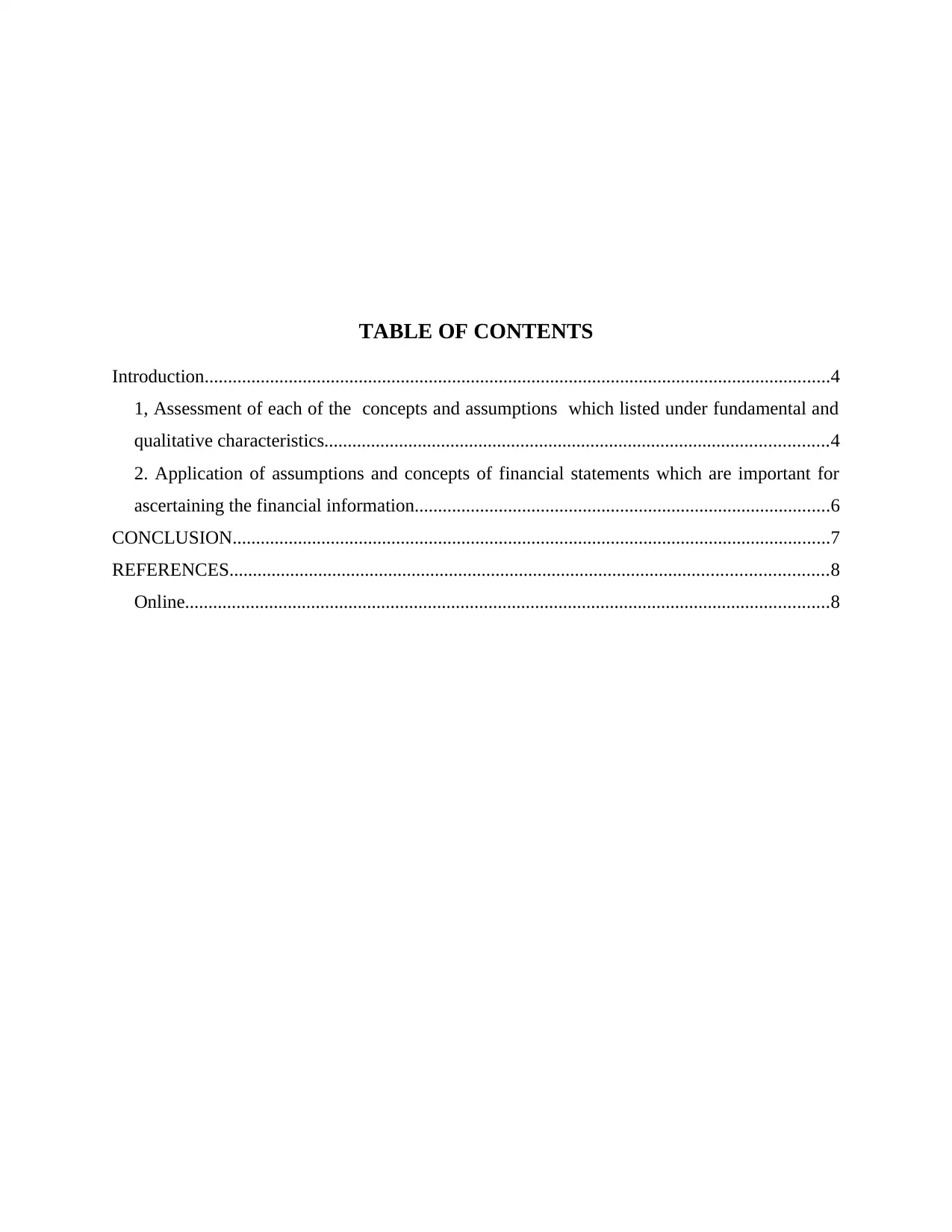
TABLE OF CONTENTS
Introduction......................................................................................................................................4
1, Assessment of each of the concepts and assumptions which listed under fundamental and
qualitative characteristics............................................................................................................4
2. Application of assumptions and concepts of financial statements which are important for
ascertaining the financial information.........................................................................................6
CONCLUSION................................................................................................................................7
REFERENCES................................................................................................................................8
Online..........................................................................................................................................8
Introduction......................................................................................................................................4
1, Assessment of each of the concepts and assumptions which listed under fundamental and
qualitative characteristics............................................................................................................4
2. Application of assumptions and concepts of financial statements which are important for
ascertaining the financial information.........................................................................................6
CONCLUSION................................................................................................................................7
REFERENCES................................................................................................................................8
Online..........................................................................................................................................8
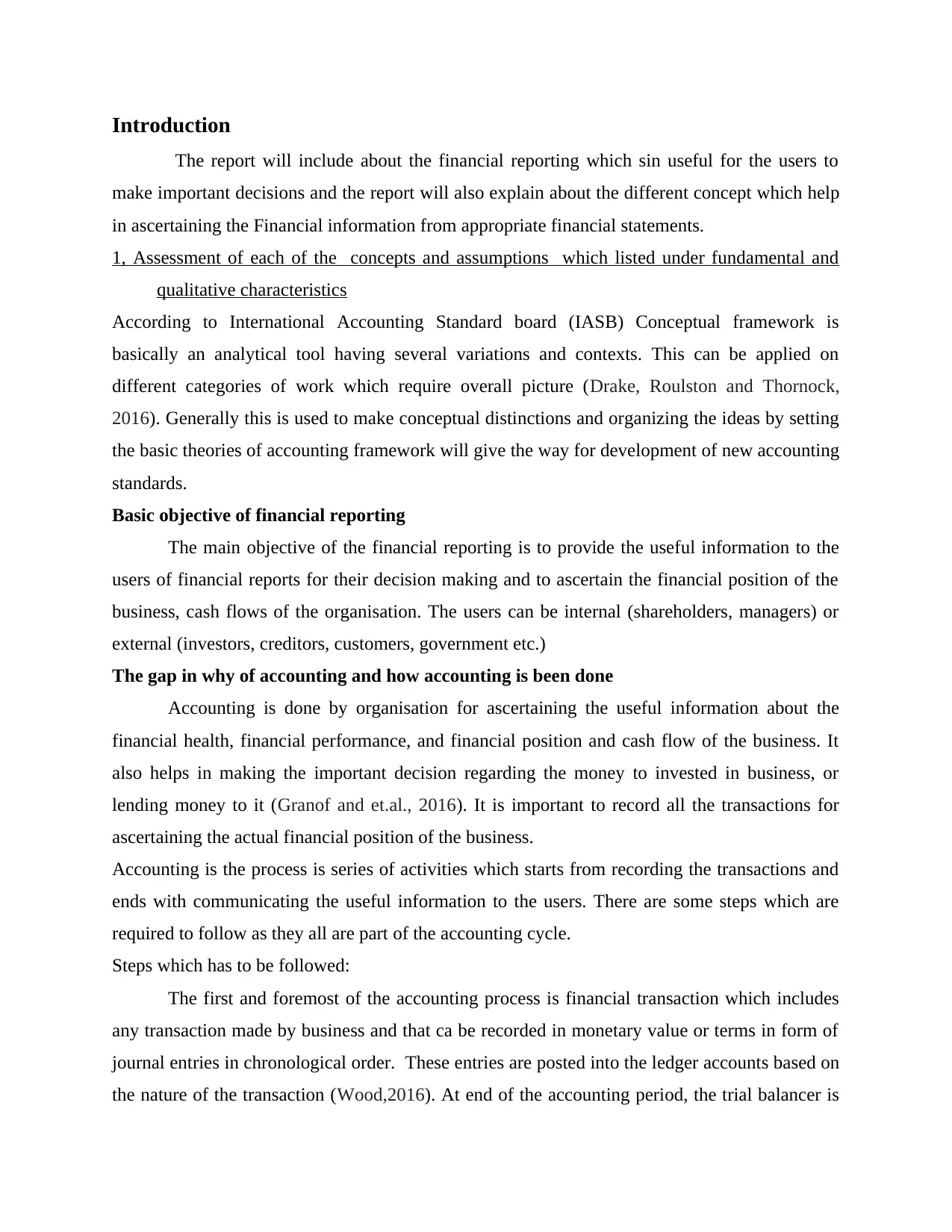
Introduction
The report will include about the financial reporting which sin useful for the users to
make important decisions and the report will also explain about the different concept which help
in ascertaining the Financial information from appropriate financial statements.
1, Assessment of each of the concepts and assumptions which listed under fundamental and
qualitative characteristics
According to International Accounting Standard board (IASB) Conceptual framework is
basically an analytical tool having several variations and contexts. This can be applied on
different categories of work which require overall picture (Drake, Roulston and Thornock,
2016). Generally this is used to make conceptual distinctions and organizing the ideas by setting
the basic theories of accounting framework will give the way for development of new accounting
standards.
Basic objective of financial reporting
The main objective of the financial reporting is to provide the useful information to the
users of financial reports for their decision making and to ascertain the financial position of the
business, cash flows of the organisation. The users can be internal (shareholders, managers) or
external (investors, creditors, customers, government etc.)
The gap in why of accounting and how accounting is been done
Accounting is done by organisation for ascertaining the useful information about the
financial health, financial performance, and financial position and cash flow of the business. It
also helps in making the important decision regarding the money to invested in business, or
lending money to it (Granof and et.al., 2016). It is important to record all the transactions for
ascertaining the actual financial position of the business.
Accounting is the process is series of activities which starts from recording the transactions and
ends with communicating the useful information to the users. There are some steps which are
required to follow as they all are part of the accounting cycle.
Steps which has to be followed:
The first and foremost of the accounting process is financial transaction which includes
any transaction made by business and that ca be recorded in monetary value or terms in form of
journal entries in chronological order. These entries are posted into the ledger accounts based on
the nature of the transaction (Wood,2016). At end of the accounting period, the trial balancer is
The report will include about the financial reporting which sin useful for the users to
make important decisions and the report will also explain about the different concept which help
in ascertaining the Financial information from appropriate financial statements.
1, Assessment of each of the concepts and assumptions which listed under fundamental and
qualitative characteristics
According to International Accounting Standard board (IASB) Conceptual framework is
basically an analytical tool having several variations and contexts. This can be applied on
different categories of work which require overall picture (Drake, Roulston and Thornock,
2016). Generally this is used to make conceptual distinctions and organizing the ideas by setting
the basic theories of accounting framework will give the way for development of new accounting
standards.
Basic objective of financial reporting
The main objective of the financial reporting is to provide the useful information to the
users of financial reports for their decision making and to ascertain the financial position of the
business, cash flows of the organisation. The users can be internal (shareholders, managers) or
external (investors, creditors, customers, government etc.)
The gap in why of accounting and how accounting is been done
Accounting is done by organisation for ascertaining the useful information about the
financial health, financial performance, and financial position and cash flow of the business. It
also helps in making the important decision regarding the money to invested in business, or
lending money to it (Granof and et.al., 2016). It is important to record all the transactions for
ascertaining the actual financial position of the business.
Accounting is the process is series of activities which starts from recording the transactions and
ends with communicating the useful information to the users. There are some steps which are
required to follow as they all are part of the accounting cycle.
Steps which has to be followed:
The first and foremost of the accounting process is financial transaction which includes
any transaction made by business and that ca be recorded in monetary value or terms in form of
journal entries in chronological order. These entries are posted into the ledger accounts based on
the nature of the transaction (Wood,2016). At end of the accounting period, the trial balancer is
⊘ This is a preview!⊘
Do you want full access?
Subscribe today to unlock all pages.

Trusted by 1+ million students worldwide
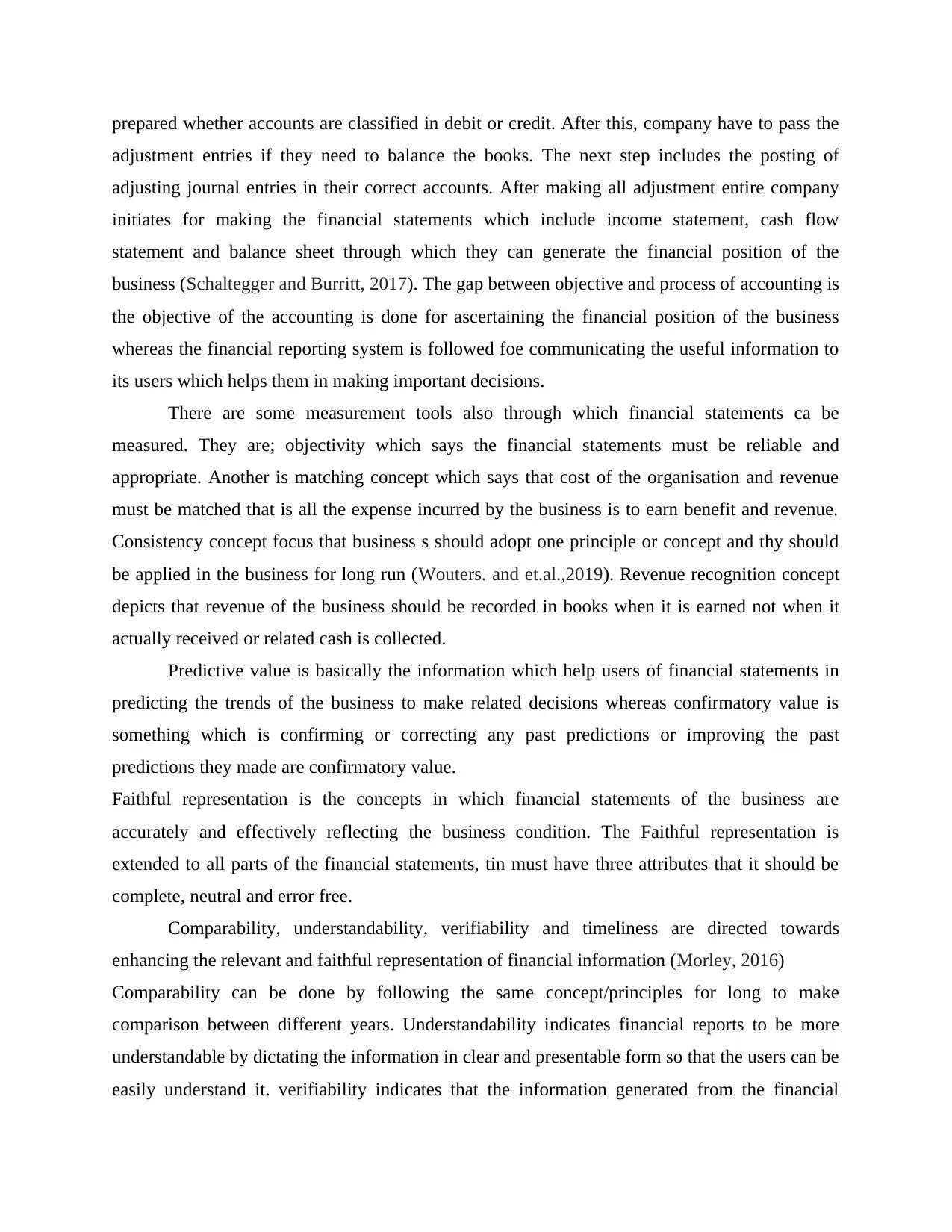
prepared whether accounts are classified in debit or credit. After this, company have to pass the
adjustment entries if they need to balance the books. The next step includes the posting of
adjusting journal entries in their correct accounts. After making all adjustment entire company
initiates for making the financial statements which include income statement, cash flow
statement and balance sheet through which they can generate the financial position of the
business (Schaltegger and Burritt, 2017). The gap between objective and process of accounting is
the objective of the accounting is done for ascertaining the financial position of the business
whereas the financial reporting system is followed foe communicating the useful information to
its users which helps them in making important decisions.
There are some measurement tools also through which financial statements ca be
measured. They are; objectivity which says the financial statements must be reliable and
appropriate. Another is matching concept which says that cost of the organisation and revenue
must be matched that is all the expense incurred by the business is to earn benefit and revenue.
Consistency concept focus that business s should adopt one principle or concept and thy should
be applied in the business for long run (Wouters. and et.al.,2019). Revenue recognition concept
depicts that revenue of the business should be recorded in books when it is earned not when it
actually received or related cash is collected.
Predictive value is basically the information which help users of financial statements in
predicting the trends of the business to make related decisions whereas confirmatory value is
something which is confirming or correcting any past predictions or improving the past
predictions they made are confirmatory value.
Faithful representation is the concepts in which financial statements of the business are
accurately and effectively reflecting the business condition. The Faithful representation is
extended to all parts of the financial statements, tin must have three attributes that it should be
complete, neutral and error free.
Comparability, understandability, verifiability and timeliness are directed towards
enhancing the relevant and faithful representation of financial information (Morley, 2016)
Comparability can be done by following the same concept/principles for long to make
comparison between different years. Understandability indicates financial reports to be more
understandable by dictating the information in clear and presentable form so that the users can be
easily understand it. verifiability indicates that the information generated from the financial
adjustment entries if they need to balance the books. The next step includes the posting of
adjusting journal entries in their correct accounts. After making all adjustment entire company
initiates for making the financial statements which include income statement, cash flow
statement and balance sheet through which they can generate the financial position of the
business (Schaltegger and Burritt, 2017). The gap between objective and process of accounting is
the objective of the accounting is done for ascertaining the financial position of the business
whereas the financial reporting system is followed foe communicating the useful information to
its users which helps them in making important decisions.
There are some measurement tools also through which financial statements ca be
measured. They are; objectivity which says the financial statements must be reliable and
appropriate. Another is matching concept which says that cost of the organisation and revenue
must be matched that is all the expense incurred by the business is to earn benefit and revenue.
Consistency concept focus that business s should adopt one principle or concept and thy should
be applied in the business for long run (Wouters. and et.al.,2019). Revenue recognition concept
depicts that revenue of the business should be recorded in books when it is earned not when it
actually received or related cash is collected.
Predictive value is basically the information which help users of financial statements in
predicting the trends of the business to make related decisions whereas confirmatory value is
something which is confirming or correcting any past predictions or improving the past
predictions they made are confirmatory value.
Faithful representation is the concepts in which financial statements of the business are
accurately and effectively reflecting the business condition. The Faithful representation is
extended to all parts of the financial statements, tin must have three attributes that it should be
complete, neutral and error free.
Comparability, understandability, verifiability and timeliness are directed towards
enhancing the relevant and faithful representation of financial information (Morley, 2016)
Comparability can be done by following the same concept/principles for long to make
comparison between different years. Understandability indicates financial reports to be more
understandable by dictating the information in clear and presentable form so that the users can be
easily understand it. verifiability indicates that the information generated from the financial
Paraphrase This Document
Need a fresh take? Get an instant paraphrase of this document with our AI Paraphraser
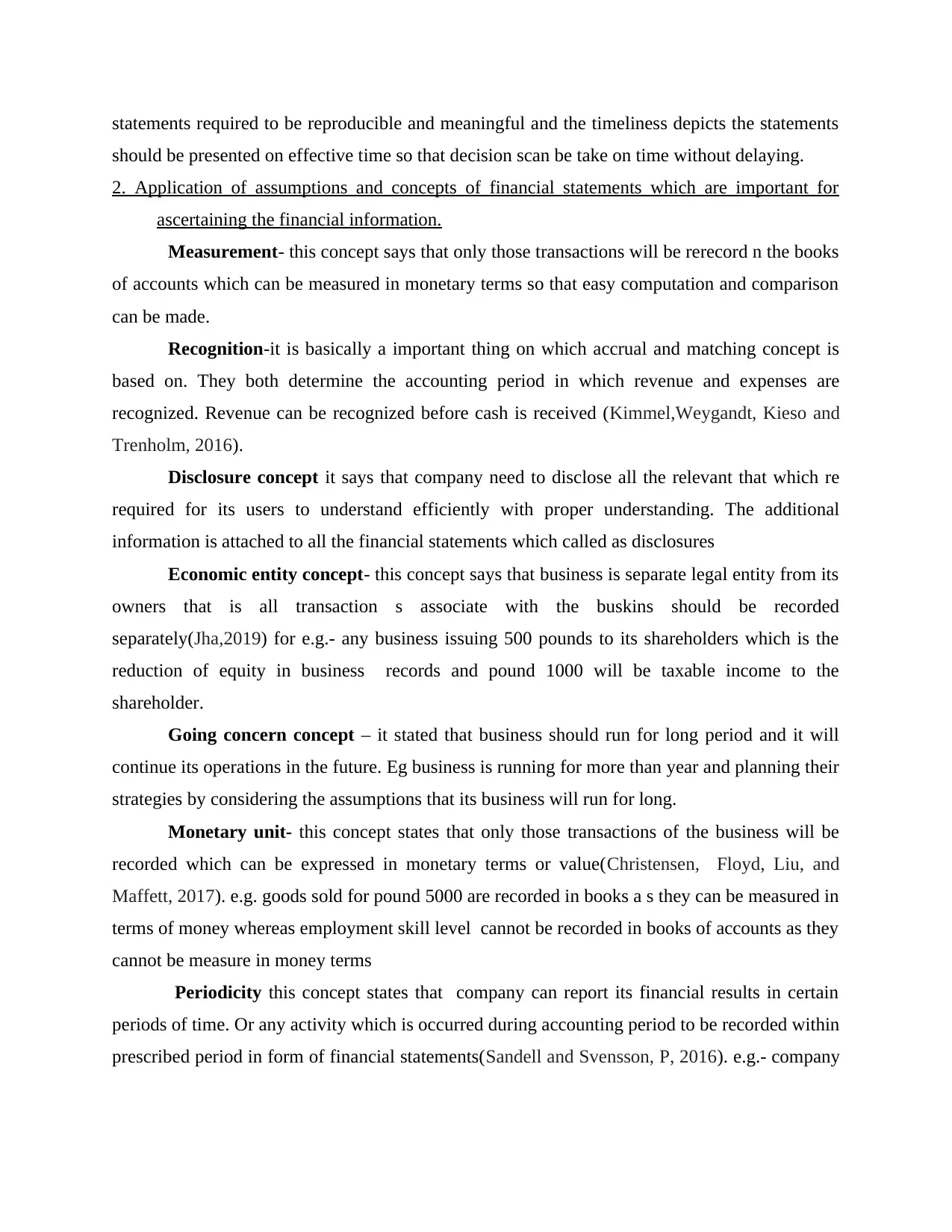
statements required to be reproducible and meaningful and the timeliness depicts the statements
should be presented on effective time so that decision scan be take on time without delaying.
2. Application of assumptions and concepts of financial statements which are important for
ascertaining the financial information.
Measurement- this concept says that only those transactions will be rerecord n the books
of accounts which can be measured in monetary terms so that easy computation and comparison
can be made.
Recognition-it is basically a important thing on which accrual and matching concept is
based on. They both determine the accounting period in which revenue and expenses are
recognized. Revenue can be recognized before cash is received (Kimmel,Weygandt, Kieso and
Trenholm, 2016).
Disclosure concept it says that company need to disclose all the relevant that which re
required for its users to understand efficiently with proper understanding. The additional
information is attached to all the financial statements which called as disclosures
Economic entity concept- this concept says that business is separate legal entity from its
owners that is all transaction s associate with the buskins should be recorded
separately(Jha,2019) for e.g.- any business issuing 500 pounds to its shareholders which is the
reduction of equity in business records and pound 1000 will be taxable income to the
shareholder.
Going concern concept – it stated that business should run for long period and it will
continue its operations in the future. Eg business is running for more than year and planning their
strategies by considering the assumptions that its business will run for long.
Monetary unit- this concept states that only those transactions of the business will be
recorded which can be expressed in monetary terms or value(Christensen, Floyd, Liu, and
Maffett, 2017). e.g. goods sold for pound 5000 are recorded in books a s they can be measured in
terms of money whereas employment skill level cannot be recorded in books of accounts as they
cannot be measure in money terms
Periodicity this concept states that company can report its financial results in certain
periods of time. Or any activity which is occurred during accounting period to be recorded within
prescribed period in form of financial statements(Sandell and Svensson, P, 2016). e.g.- company
should be presented on effective time so that decision scan be take on time without delaying.
2. Application of assumptions and concepts of financial statements which are important for
ascertaining the financial information.
Measurement- this concept says that only those transactions will be rerecord n the books
of accounts which can be measured in monetary terms so that easy computation and comparison
can be made.
Recognition-it is basically a important thing on which accrual and matching concept is
based on. They both determine the accounting period in which revenue and expenses are
recognized. Revenue can be recognized before cash is received (Kimmel,Weygandt, Kieso and
Trenholm, 2016).
Disclosure concept it says that company need to disclose all the relevant that which re
required for its users to understand efficiently with proper understanding. The additional
information is attached to all the financial statements which called as disclosures
Economic entity concept- this concept says that business is separate legal entity from its
owners that is all transaction s associate with the buskins should be recorded
separately(Jha,2019) for e.g.- any business issuing 500 pounds to its shareholders which is the
reduction of equity in business records and pound 1000 will be taxable income to the
shareholder.
Going concern concept – it stated that business should run for long period and it will
continue its operations in the future. Eg business is running for more than year and planning their
strategies by considering the assumptions that its business will run for long.
Monetary unit- this concept states that only those transactions of the business will be
recorded which can be expressed in monetary terms or value(Christensen, Floyd, Liu, and
Maffett, 2017). e.g. goods sold for pound 5000 are recorded in books a s they can be measured in
terms of money whereas employment skill level cannot be recorded in books of accounts as they
cannot be measure in money terms
Periodicity this concept states that company can report its financial results in certain
periods of time. Or any activity which is occurred during accounting period to be recorded within
prescribed period in form of financial statements(Sandell and Svensson, P, 2016). e.g.- company
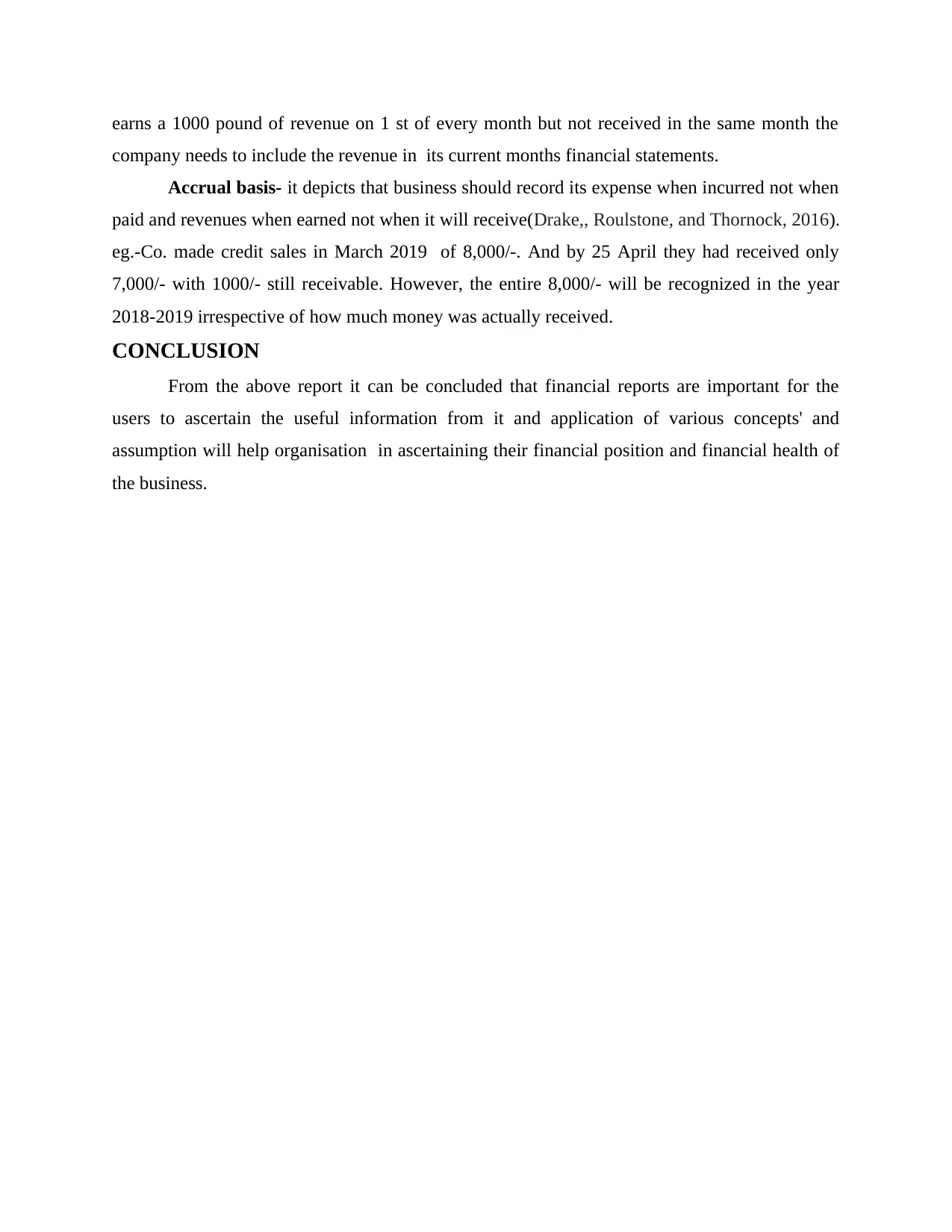
earns a 1000 pound of revenue on 1 st of every month but not received in the same month the
company needs to include the revenue in its current months financial statements.
Accrual basis- it depicts that business should record its expense when incurred not when
paid and revenues when earned not when it will receive(Drake,, Roulstone, and Thornock, 2016).
eg.-Co. made credit sales in March 2019 of 8,000/-. And by 25 April they had received only
7,000/- with 1000/- still receivable. However, the entire 8,000/- will be recognized in the year
2018-2019 irrespective of how much money was actually received.
CONCLUSION
From the above report it can be concluded that financial reports are important for the
users to ascertain the useful information from it and application of various concepts' and
assumption will help organisation in ascertaining their financial position and financial health of
the business.
company needs to include the revenue in its current months financial statements.
Accrual basis- it depicts that business should record its expense when incurred not when
paid and revenues when earned not when it will receive(Drake,, Roulstone, and Thornock, 2016).
eg.-Co. made credit sales in March 2019 of 8,000/-. And by 25 April they had received only
7,000/- with 1000/- still receivable. However, the entire 8,000/- will be recognized in the year
2018-2019 irrespective of how much money was actually received.
CONCLUSION
From the above report it can be concluded that financial reports are important for the
users to ascertain the useful information from it and application of various concepts' and
assumption will help organisation in ascertaining their financial position and financial health of
the business.
⊘ This is a preview!⊘
Do you want full access?
Subscribe today to unlock all pages.

Trusted by 1+ million students worldwide
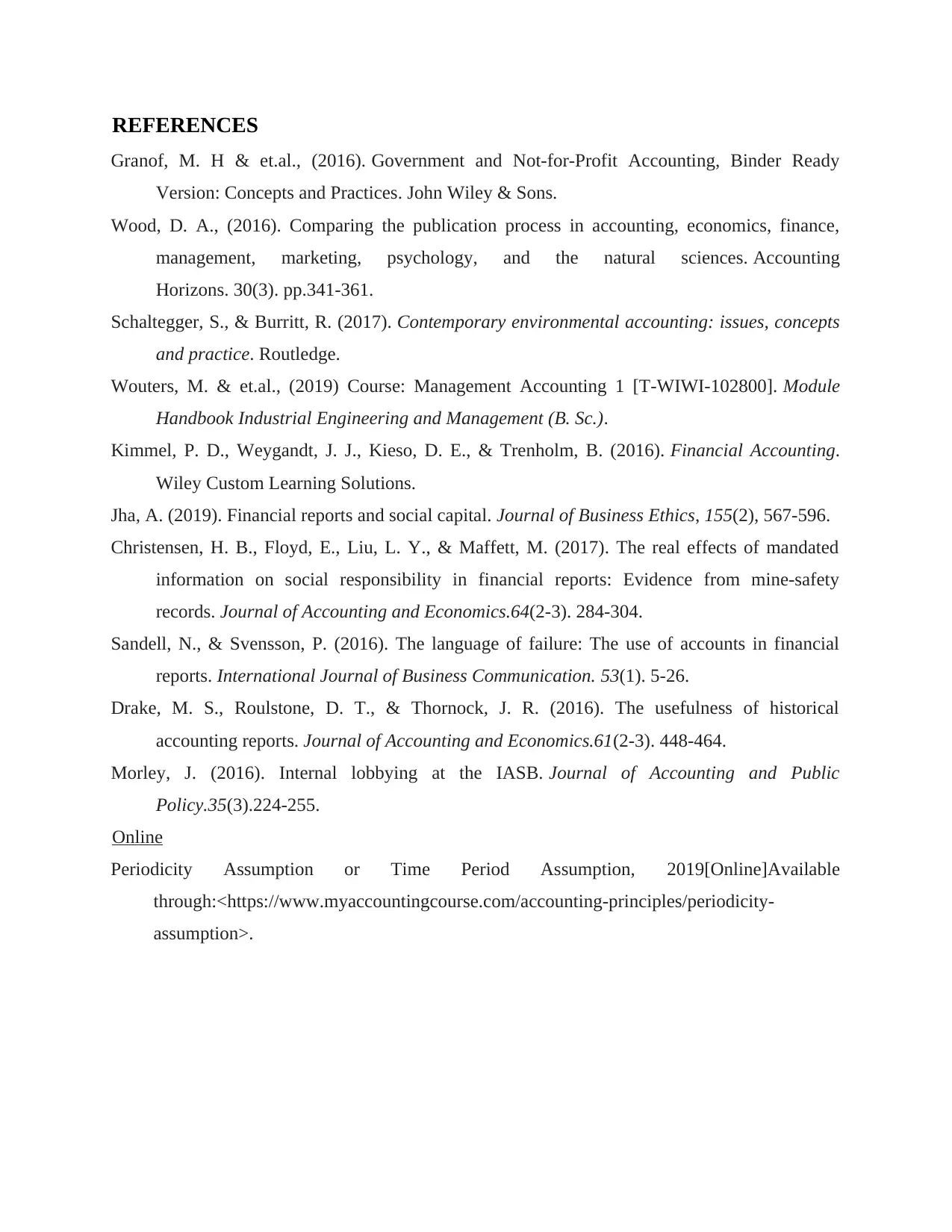
REFERENCES
Granof, M. H & et.al., (2016). Government and Not-for-Profit Accounting, Binder Ready
Version: Concepts and Practices. John Wiley & Sons.
Wood, D. A., (2016). Comparing the publication process in accounting, economics, finance,
management, marketing, psychology, and the natural sciences. Accounting
Horizons. 30(3). pp.341-361.
Schaltegger, S., & Burritt, R. (2017). Contemporary environmental accounting: issues, concepts
and practice. Routledge.
Wouters, M. & et.al., (2019) Course: Management Accounting 1 [T-WIWI-102800]. Module
Handbook Industrial Engineering and Management (B. Sc.).
Kimmel, P. D., Weygandt, J. J., Kieso, D. E., & Trenholm, B. (2016). Financial Accounting.
Wiley Custom Learning Solutions.
Jha, A. (2019). Financial reports and social capital. Journal of Business Ethics, 155(2), 567-596.
Christensen, H. B., Floyd, E., Liu, L. Y., & Maffett, M. (2017). The real effects of mandated
information on social responsibility in financial reports: Evidence from mine-safety
records. Journal of Accounting and Economics.64(2-3). 284-304.
Sandell, N., & Svensson, P. (2016). The language of failure: The use of accounts in financial
reports. International Journal of Business Communication. 53(1). 5-26.
Drake, M. S., Roulstone, D. T., & Thornock, J. R. (2016). The usefulness of historical
accounting reports. Journal of Accounting and Economics.61(2-3). 448-464.
Morley, J. (2016). Internal lobbying at the IASB. Journal of Accounting and Public
Policy.35(3).224-255.
Online
Periodicity Assumption or Time Period Assumption, 2019[Online]Available
through:<https://www.myaccountingcourse.com/accounting-principles/periodicity-
assumption>.
Granof, M. H & et.al., (2016). Government and Not-for-Profit Accounting, Binder Ready
Version: Concepts and Practices. John Wiley & Sons.
Wood, D. A., (2016). Comparing the publication process in accounting, economics, finance,
management, marketing, psychology, and the natural sciences. Accounting
Horizons. 30(3). pp.341-361.
Schaltegger, S., & Burritt, R. (2017). Contemporary environmental accounting: issues, concepts
and practice. Routledge.
Wouters, M. & et.al., (2019) Course: Management Accounting 1 [T-WIWI-102800]. Module
Handbook Industrial Engineering and Management (B. Sc.).
Kimmel, P. D., Weygandt, J. J., Kieso, D. E., & Trenholm, B. (2016). Financial Accounting.
Wiley Custom Learning Solutions.
Jha, A. (2019). Financial reports and social capital. Journal of Business Ethics, 155(2), 567-596.
Christensen, H. B., Floyd, E., Liu, L. Y., & Maffett, M. (2017). The real effects of mandated
information on social responsibility in financial reports: Evidence from mine-safety
records. Journal of Accounting and Economics.64(2-3). 284-304.
Sandell, N., & Svensson, P. (2016). The language of failure: The use of accounts in financial
reports. International Journal of Business Communication. 53(1). 5-26.
Drake, M. S., Roulstone, D. T., & Thornock, J. R. (2016). The usefulness of historical
accounting reports. Journal of Accounting and Economics.61(2-3). 448-464.
Morley, J. (2016). Internal lobbying at the IASB. Journal of Accounting and Public
Policy.35(3).224-255.
Online
Periodicity Assumption or Time Period Assumption, 2019[Online]Available
through:<https://www.myaccountingcourse.com/accounting-principles/periodicity-
assumption>.
Paraphrase This Document
Need a fresh take? Get an instant paraphrase of this document with our AI Paraphraser


⊘ This is a preview!⊘
Do you want full access?
Subscribe today to unlock all pages.

Trusted by 1+ million students worldwide

Paraphrase This Document
Need a fresh take? Get an instant paraphrase of this document with our AI Paraphraser

1 out of 11
Related Documents
Your All-in-One AI-Powered Toolkit for Academic Success.
+13062052269
info@desklib.com
Available 24*7 on WhatsApp / Email
![[object Object]](/_next/static/media/star-bottom.7253800d.svg)
Unlock your academic potential
Copyright © 2020–2025 A2Z Services. All Rights Reserved. Developed and managed by ZUCOL.





